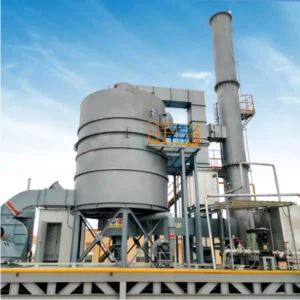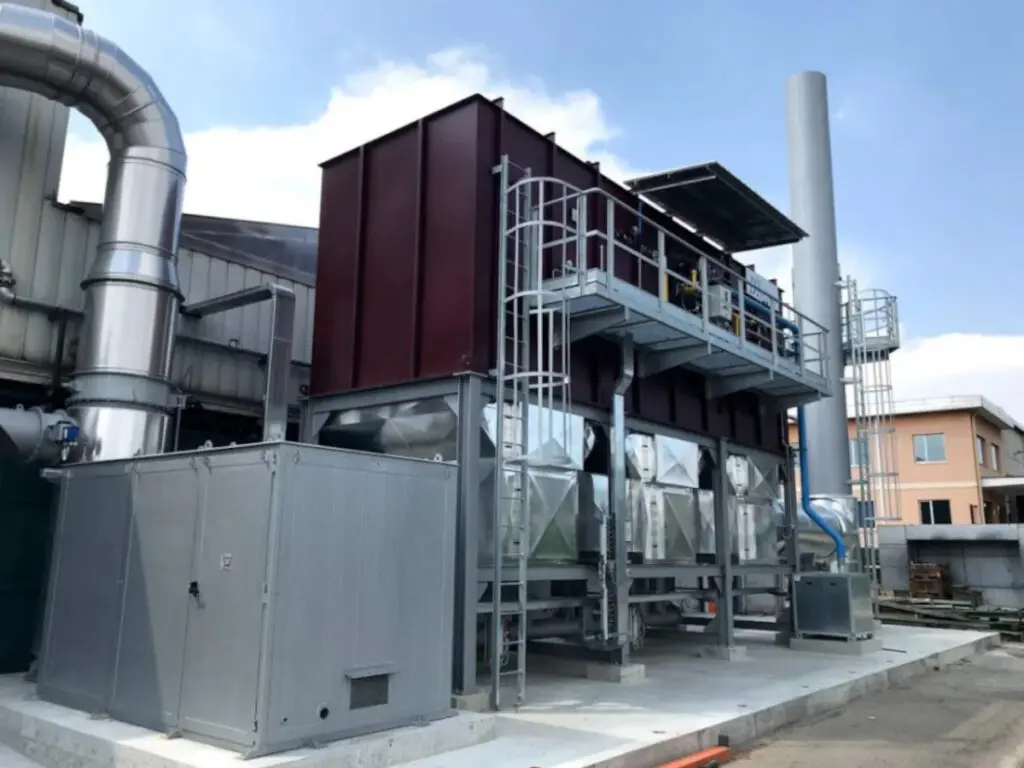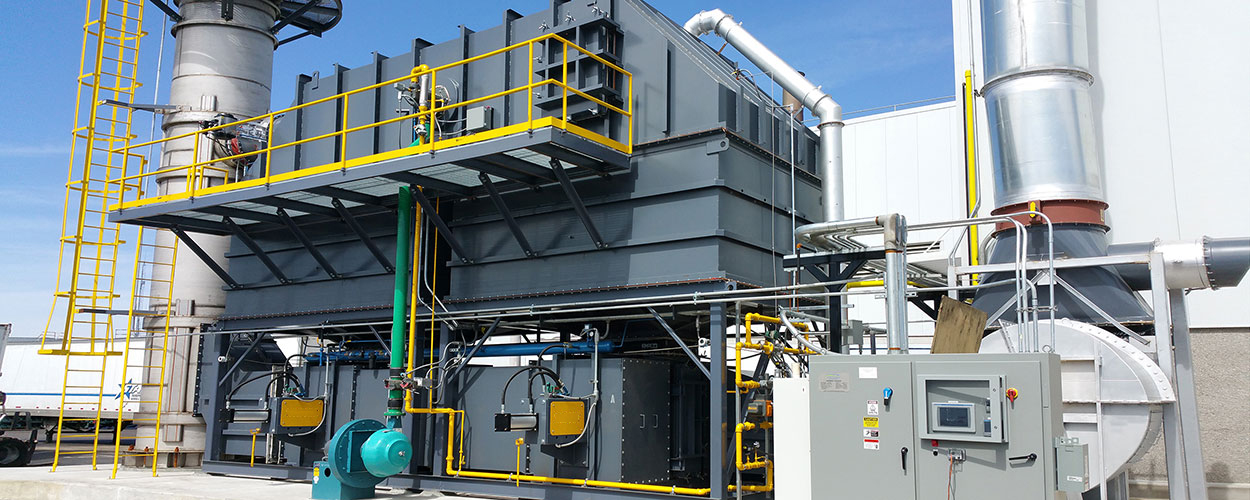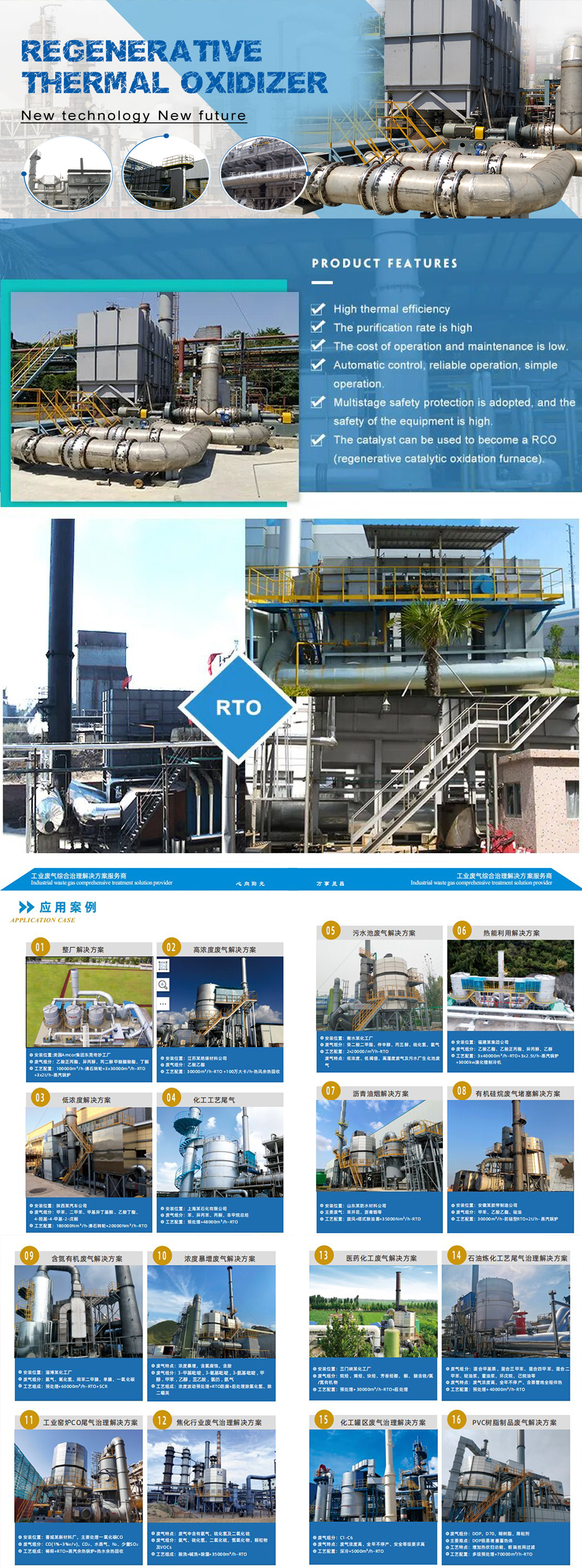Basic Info.
Model NO.
RTO
Type
Environmental Monitoring Instrument
Brand
Raidsant
Condition
New
Clean Efficeincy
99.8%
Application
Chemical Industry
Main Function
Waste Gases Removal
Trademark
Raidsant
Transport Package
Film Wrapped
Origin
ZheJiang China
Product Description
HangZhou Raidsant Machinery Co.;,; Ltd.; is majored in developing and manufacturing innovativepowder cooling pelletizing machinery and related industrial waste gas treatment machine.; With nearly 20 years’ production history,; we have a good market in more than 20 provinces in China,; and some of our products were exported to Saudi Arabia,;Singapore,;Mexico,; Brazil,;Spain,; America,; Russia and Korea,; etc.;
Specifications:;
* More compact than the existing facilities
* Low-operation costs
* Long lifespan of facilities
* No changes in pressure
Purpose:;
Energy-saving system that burns volatile organic compound (VOC); and waste gas by using heat,; and it collects over 99.;8% of waste heat of exhaust gas by using ceramic regenerative materials (catalyst); with large surface area and low-pressure loss.;
Applications:;
1.; Painting drying process
2.; metal printing process
3.; fiber drying process
4.; adhesive tape process
5.; waste treatment process
6.; semiconductor manufacturing process
7.; smoke,; confectionary and baking process
8.; petrochemical process,;
9.; medicine and food manufacturing process,;
10.; other VOC generating process
Merits:;
* More compact than the existing facilities
* No changes in pressure
* High-heat recovery rate (over 95%);
* Perfect VOC treatment (over 99.;8%);
* Long lifespan of facilities
* Low-operation costs
* Able to be manufactured in circle or quadrangle
General Descriptions and Features:;
1.; Operating principle
Operation method that continuously changing discharges by rotating the Rotary Valve
2.; Process Pressure Change
No pressure change because wind direction changes in order by the Rotary Valve rotation
3.; Investment Costs
Around 70% of Bed Type
4.; Installation Space
It is single vessel so it is compact and requires less installation space.;
5.; Maintenance
It is easy to maintain it because Rotary Valve is the only 1 moving part.;
Rotary Valve’s sealing part is rarely worn out because it rotates at low speed.;
6.; Stability
No risks in the process because it is always opened even when the Rotary Valve has troubles.;
7.; Treatment Efficiency
Treatment efficiency maintains because sealing part is rarely worn out even if it is operated for a long time.;
Address: No.3,Zhenxin Middle Road, Economic Development Zone,HangZhou,ZheJiang
Business Type: Manufacturer/Factory, Trading Company
Business Range: Chemicals, Electrical & Electronics, Manufacturing & Processing Machinery, Security & Protection
Management System Certification: ISO 9001
Main Products: Pelletizer, Flaker, Pastillator, Granulator, Chemical Pelletizer, Vocs
Company Introduction: HangZhou Raidsant Machinery Co., Ltd. ., previously called HangZhou Xinte Plastic Machinery Factory is majored in producing innovative plastic recycling machinery. With nearly 20 years′ experience, we have a good market in 20 provinces in China, and some of our products were exported to Indonesia, Russia and Vietnam, etc. Our main products include DZ Type Pastillator, waste tire recycling line, Big Calibre Plastic Pipe shredders recycling line, continuous annealing tin-coation machine, QX type PET, PE & hull washing line, SDP double rails plastic recycling crusher, SJ hot cutting granule making unit, PVC tube (cinquefoil) product line, PVC Odd-shaped material product line for door and window, granule product line in water and Shredder for plastics and recycling. We acquired 5 technical patents.
Our corpotation lays emphsis on thchnical reconstruction, imports advanced technology from home and abroad, and develops new products constantly. Our tenet is challenging for hight quality, offering the best products. We are making efforts to realize our slogan. Satisfying our customers is our everlasting pursuit.
We are looking for the oversea customers or agents. If you are interested in our proposal, please let us know which of our products is the most likely to appeal to you or your customers. We should be very grateful if you give us some ideas of the marketprospects for our products. We hope to hear favorable information from you soon! It is our goal that we wish we could buid a good relationship with you now or in the near future. Please do not hesitate to contact us if you have any question or request.
We also sincerely welcome you to our company to discuss business and negotiate with us. For further expanding our market and customers, our company welcomes customer from domestic and aboard in an new-brand gesture on the basis of full-new mangement conception—quality, honour, service. We are looking for ISO 90001 mangement quality system to meet with our customers requirement!

Can regenerative thermal oxidizers handle variable pollutant concentrations?
Regenerative thermal oxidizers (RTOs) are designed to handle variable pollutant concentrations effectively. They are capable of accommodating fluctuations in pollutant concentrations without significant adverse effects on their performance or efficiency. The ability of RTOs to handle variable pollutant concentrations is one of the advantages that make them suitable for a wide range of industrial applications.
Here are some key points to consider regarding the capability of RTOs to handle variable pollutant concentrations:
- High Destruction Efficiency: RTOs are known for their high destruction efficiency, which refers to their ability to effectively destroy or oxidize the pollutants present in the exhaust gases. The combustion chamber within the RTO is designed to maintain a sufficiently high temperature to ensure complete oxidation of the pollutants, regardless of their concentration.
- Retention Time: RTOs are designed with a sufficient residence or retention time within the combustion chamber. This allows the exhaust gases to spend enough time in the high-temperature zone, ensuring that even pollutants with varying concentrations are adequately treated and oxidized.
- Heat Recovery: The heat recovery system in an RTO, typically using ceramic media beds or heat exchangers, plays a crucial role in handling variable pollutant concentrations. The heat recovery system helps maintain the required temperature and provides thermal energy to sustain the combustion process, even during periods of low pollutant concentrations.
- Dynamic Operation: RTOs are designed to operate dynamically, meaning they can adjust their operating parameters to accommodate changes in pollutant concentrations. They can modulate variables such as the flow rates of the exhaust gases and incoming untreated gases, the temperature setpoints, and the switching frequency of the beds to optimize performance under varying pollutant loads.
- Monitoring and Controls: RTOs are equipped with advanced monitoring and control systems that continuously monitor pollutant concentrations, temperature, and other relevant parameters. These systems enable real-time adjustments and optimization of the RTO operation to ensure effective treatment of variable pollutant concentrations.
While RTOs can handle variable pollutant concentrations, it’s important to note that extreme or highly fluctuating pollutant concentrations may require additional considerations. In some cases, pre-treatment methods such as dilution or conditioning of the exhaust gases may be employed to ensure optimal performance of the RTO.
Overall, RTOs are versatile and reliable systems that can effectively handle variable pollutant concentrations, providing efficient and consistent treatment of industrial emissions.

What are the typical construction materials used in regenerative thermal oxidizers?
Regenerative thermal oxidizers (RTOs) are constructed using various materials that can withstand the high temperatures, corrosive environments, and mechanical stresses encountered during operation. The choice of materials depends on factors such as the specific design, process conditions, and the types of pollutants being treated. Here are some typical construction materials used in RTOs:
- Heat Exchangers: The heat exchangers in RTOs are responsible for transferring heat from the outgoing exhaust gas to the incoming process air or gas stream. The construction materials for heat exchangers often include:
- Ceramic Media: RTOs commonly use structured ceramic media, such as ceramic monoliths or ceramic saddles. These materials have excellent thermal properties, high resistance to thermal shock, and good chemical resistance. Ceramic media provide a large surface area for efficient heat transfer.
- Metallic Media: Some RTO designs may incorporate metallic heat exchangers made from alloys such as stainless steel or other heat-resistant metals. Metallic media offer robustness and durability, particularly in applications with high mechanical stresses or corrosive environments.
- Combustion Chamber: The combustion chamber of an RTO is where the oxidation of pollutants takes place. The construction materials for the combustion chamber should be able to withstand the high temperatures and corrosive conditions. Commonly used materials include:
- Refractory Lining: RTOs often have refractory lining in the combustion chamber to provide thermal insulation and protection. Refractory materials, such as high-alumina or silicon carbide, are chosen for their high-temperature resistance and chemical stability.
- Steel or Alloys: The structural components of the combustion chamber, such as the walls, roof, and floor, are typically made of steel or heat-resistant alloys. These materials offer strength and stability while withstanding the high temperatures and corrosive gases.
- Ductwork and Piping: The ductwork and piping in an RTO transport the exhaust gas, process air, and auxiliary gases. The materials used for ductwork and piping depend on the specific requirements, but commonly used materials include:
- Mild Steel: Mild steel is often used for ductwork and piping in less corrosive environments. It provides strength and cost-effectiveness.
- Stainless Steel: In applications where corrosion resistance is crucial, stainless steel, such as 304 or 316 grades, may be used. Stainless steel offers excellent resistance to many corrosive gases and environments.
- Corrosion-Resistant Alloys: In highly corrosive environments, corrosion-resistant alloys like Hastelloy or Inconel may be employed. These materials provide exceptional resistance to a wide range of corrosive chemicals and gases.
- Insulation: Insulation materials are used to minimize heat loss from the RTO and ensure energy efficiency. Common insulation materials include:
- Ceramic Fiber: Ceramic fiber insulation offers excellent thermal resistance and low thermal conductivity. It is often used in RTOs to reduce heat loss and improve overall energy efficiency.
- Mineral Wool: Mineral wool insulation provides good thermal insulation and sound absorption properties. It is commonly used in RTOs to reduce heat loss and enhance safety.
It is important to note that the specific materials used in RTO construction may vary depending on factors such as the process requirements, temperature range, and corrosive nature of the gases being treated. Manufacturers of RTOs typically select appropriate materials based on their expertise and the specific application.

What is a regenerative thermal oxidizer?
A regenerative thermal oxidizer (RTO) is an advanced air pollution control device used in industrial applications to remove volatile organic compounds (VOCs), hazardous air pollutants (HAPs), and other airborne contaminants from exhaust gases. It operates by using high temperatures to thermally decompose or oxidize the pollutants, converting them into less harmful byproducts.
How does a regenerative thermal oxidizer work?
An RTO consists of several key components and operates through a cyclical process:
1. Inlet Plenum: The exhaust gases containing pollutants enter the RTO through the inlet plenum.
2. Heat Exchanger Beds: The RTO contains multiple heat exchanger beds filled with heat storage media, typically ceramic materials or structured packing. The heat exchanger beds are arranged in pairs.
3. Flow Control Valves: Flow control valves direct the airflow and control the direction of the exhaust gases through the RTO.
4. Combustion Chamber: The exhaust gases, now directed into the combustion chamber, are heated to a high temperature, typically between 1400°F (760°C) and 1600°F (870°C). This temperature range ensures effective thermal oxidation of the pollutants.
5. VOC Destruction: The high temperature in the combustion chamber causes the VOCs and other contaminants to react with oxygen, resulting in their thermal decomposition or oxidation. This process breaks down the pollutants into water vapor, carbon dioxide, and other harmless gases.
6. Heat Recovery: The hot, purified gases leaving the combustion chamber pass through the outlet plenum and flow through the heat exchanger beds that are in the opposite phase of operation. The heat storage media in the beds absorb heat from the outgoing gases, which preheats the incoming exhaust gases.
7. Cycle Switching: After a specific time interval, the flow control valves switch the airflow direction, allowing the heat exchanger beds that were preheating the incoming gases to now receive the hot gases from the combustion chamber. The cycle then repeats, ensuring continuous and efficient operation.
Advantages of regenerative thermal oxidizers:
RTOs offer several advantages in industrial air pollution control:
1. High Efficiency: RTOs can achieve high destruction efficiencies, typically above 95%, effectively removing a wide range of pollutants.
2. Energy Recovery: The heat recovery mechanism in RTOs allows for significant energy savings. The preheating of incoming gases reduces the fuel consumption required for combustion, making RTOs energy-efficient.
3. Cost-effectiveness: Although the initial capital investment for an RTO can be significant, the long-term operational cost savings through energy recovery and high destruction efficiencies make it a cost-effective solution over the lifespan of the system.
4. Environmental Compliance: RTOs are designed to meet stringent emissions regulations and help industries comply with air quality standards and permits.
5. Versatility: RTOs can handle a wide range of process exhaust volumes and pollutant concentrations, making them suitable for various industrial applications.
Overall, regenerative thermal oxidizers are highly efficient and effective air pollution control devices widely used in industries to minimize emissions and ensure environmental compliance.

editor by CX 2023-10-22
